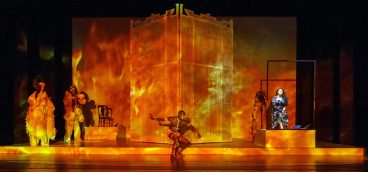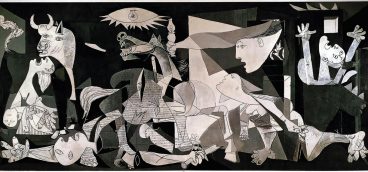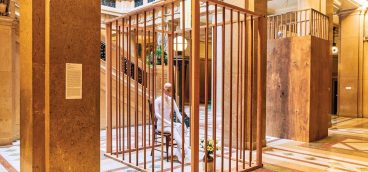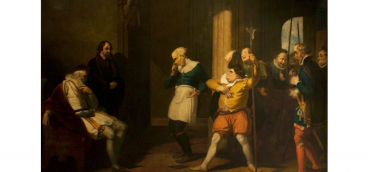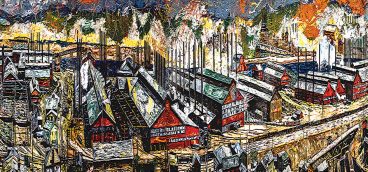
Like it or not, the Carnegie International eclipses everything the Carnegie Museum of Art does. Every director has grumbled about how it commandeers all available resources. But it’s a time-honored tradition, still associated 125 years later with the values of founding father Andrew Carnegie. It has survived the vicissitudes of world wars, economic crises, evolving technologies, life and leadership styles, hubris, doubts, and fatigue. It has withstood attacks, questions, and disappointments, countering with triumphs, a firm belief in continuity and identity, and even reevaluation.
It has been tenacious, even when the critics lambasted it, once describing a room dedicated to abstract art as “a padded cell for the unruly,” asking, “Is it art?” more than once, raising concerns about so-called communist artists, and damning some shows with faint praise. The 1982 version elicited practically universal disdain, dismissed at an opening weekend symposium as “a very bad show” and “a major disappointment.” Roberta Smith, of the New York Times went even further, saying that she “basically found nothing in this show that I would ever want to see again.”
The next version, in 1985, was hailed, with relief, as a success. Since then, the response has included mostly polite and some celebratory comments addressing the format, themes, and range of artists chosen. Yet even when the criticism bordered on vitriolic, very few went so far as to question whether it should continue. Even Roberta Smith, so upset with the 1982 version, still maintained that the tradition was important to continue.
This year’s version, the 58th in the series, felt different. Perhaps it was ennui from the pandemic lockdown, but there wasn’t the usual build-up of excitement, with rumors about which artists were in the show. Many just weren’t interested, even longtime Pittsburghers who had seen every other version. Some skipped the show, and those who attended didn’t rave about work that captured their imagination. In fact, many felt left in the dark unless they read every single label. Lots of reviews mentioned that disconnect, including the New York Times: “The 58th edition of North America’s longest-running international art show is a deluge of art and information that left me with an urgent, unsettled question: Who, or what, are shows like this for?”
The Times went on to suggest that the International was a first draft of what could have been a much more serious exploration of the curator’s desire to examine the geopolitical imprint of the U.S. post 1945. Sohrab Mohebbi’s use of a more decentralized organization that relied more than usual on artists was seen as a strategy to increase diversity and inclusivity. There was a wider international scope, with artists from regions not previously included, but many lamented the lack of “wow” moments. Were beauty and aesthetics sacrificed or, perhaps, not even a concern? For the first time, most artists were unknown. Their work had not been seen in the other international shows, nor were they represented by the usual blue-chip galleries. Was this a dramatic correction to past practices or the road to aesthetic bankruptcy and boredom?
These questions about the 58th International beg for a serious reconsideration, especially now when the art world is confronted with challenges from many directions. Museums are being questioned about how they operate, what and whom they include, and how they present art. As the Carnegie Museum of Art’s largest endeavor, the International has the potential to be a leader in the field of contemporary art with strategies and practices that come from an understanding of the history and brand of the show. Can it meet the challenge?
The primary questions to ask: Has the Carnegie International served its purpose and should it be allowed to rest in peace or can it be reimagined for our times? How should the museum balance the costs of this one show with the rest of its program? Is the International still relevant? Is the format of a large-scale survey still appropriate or is there a way to redefine the very idea of the International to continue, alter, or expand its impact? Is the show organized for art world insiders or for audiences in Pittsburgh? With the instant gratification of the internet, viewers can access art easily and quickly, so perhaps they don’t feel the need to travel to see this show, especially when the alternatives take place on every continent in exciting places from Venice to Istanbul, São Paulo, and various sites in Japan and East Asia. Does the International still belong on the contemporary art pilgrimage?

These are difficult questions to answer. The International is not a singular event; it occurs in a much larger context. What is happening to other exhibitions of international contemporary art? What demands or changes are challenging art museums today? What is the status of the show at the Carnegie Museum of Art and how does that affect how the museum defines itself and makes decisions? Has the institution ever initiated a serious rethink of the show and its importance? These factors can provide the context needed for such a reconsideration of the show that was established in the late 19th century and now operates in the 21st century.
***
Pittsburgh’s is one of three major international exhibits in the West, all of which took place in 2022-23. The International and the Biennale are long-running, while the youngster, Documenta, started in 1955. The New York Times reported that the 2022 budget for Documenta exceeded $40 million. Attendance was reported at 768,000 at its 15 locations in Kassel, Germany, during its 100-day run. That was a decrease of 17 percent from its last version. Venice spent more than $20 million last year for its Biennale, which attracted 822,500 in 197 days, a 35 percent increase over its last iteration.
The International’s figures are much smaller and questionable because the Carnegie counts everyone who comes in the many doors of the whole building and cannot distinguish International visitors from those who come to see the hugely popular dinosaurs. Carnegie Museum of Art staff said the budget for the most recent International was $5 million and that it had 242,000 visitors. Is that possible, when it reported 235,819 visitors in pre-pandemic 2019? It reports that the statistics for the 57th International in 2018-2019 were 200,000, and 163,000 for the 56th International in 2013. If accurate, those figures indicate a constant, almost 22 percent visitor increase for each of the recent Internationals.
Regardless of how many people actually attend such exhibits, art critics write about them. While the last Biennale drew more favorable reviews, the last Documenta faced charges of political incorrectness with several incidents of “harassment,” “antisemitism,” and “racism,” as well as sheer “incompetence,” with some contested works removed by the organizers and some by the artists. The New York Times pointed out several problems, starting with the organization, done by artists, usually in collectives, rather than well-heeled curators. This empowerment of the artists “has rotted [Documenta] into a festival of bad faith and victimology, those twin markers of the Trump-Twitter Decade.” A sense of “feel-good collectivity and sharing” replaced aesthetic values resulting in “failure,” “disgrace,” “catastrophe,” and “dreadful embarrassment” with the death of the “dream of a global art world.” The viewer had become “obsolete.” While critique of the International wasn’t as caustic, there were similar concerns. The attempt by both shows to decentralize the curatorial process and empower the voice of artists raised questions about the role of curators, and the works in both shows seemed unnecessarily obtuse, leaving viewers confused.
Carnegie Museum of Art Director Eric Crosby, however, maintained that, “The 58th Carnegie International was the most important globally representative, interdisciplinary International in the museum’s history. We aim to build on the success of this exhibition by continuing to show work by artists around the world who are grappling with the most urgent issues of our time. Through commissions, engaged curatorial work, and rigorous curatorial research, we hope to shed light on artistic practices that have yet to be celebrated in the U.S.”
***
The three-way tug-of-war between institutions claiming the importance of their exhibits, artists and critics pointing out shortcomings, and the public throwing up its hands in confusion or disgust is a pattern that has followed international shows for a long time. The recent questions asked about these large-scale, blockbuster-wannabe exhibits are many. Should the legitimacy of the U.S. and other nation states be reassessed? Are the museums and their exhibitions “diverse and inclusive” enough? Is there any place for aesthetics in art or should moral issues of social justice predominate? And should there be diverging views of social justice? Should artists “compete” for prizes or is competition itself somehow anti-egalitarian, anti-inclusive and anti-diversity? Should pieces by white male artists in museum collections be sold in favor of acquiring “more diverse” artists? Clearly, a political power struggle is underway, reminiscent of the 1960s and 1970s.
Beyond the political issues du jour, however, are others which, while also not new, get to the heart of how the museum should spend its money and for whom it actually exists. For example, should the Carnegie spend a disproportionately large share of its curatorial budget on the International — which seems to be designed more to appeal to a small group of art insiders and less aimed at its Pittsburgh supporters? Or should it spread its budget more evenly, offering a more robust schedule of varied exhibits each year?
“It is the proverbial tail that has wagged the dog,” wrote former Museum of Art director (1969-1980) Leon Arkus, of the museum’s most prominent program and consumer of resources. Having one main exhibit limits special exhibitions programming, which attracts returning visitors and increases access to different kinds of art. It might be unfair to compare current offerings with those from the past several decades when resources were more plentiful and the Museum of Art was the crown jewel of the visual arts environment in Pittsburgh. But in the past, there were more shows of contemporary art that complemented the International, revealing various points of view in the age of pluralism. The Forum Gallery was established in 1991 to add a continuing series of small-scale shows of contemporary art. The museum also managed to curate important shows of contemporary and historic art in all mediums that traveled to other venues and helped establish the museum’s reputation outside of the city. That allowed it to get more important traveling shows from other venues.
Visitors have been complaining in the last decade of fewer and less interesting shows. The Cleveland Museum of Art, for example, has a fuller and broader-based exhibitions program, and the contemporary department’s dedicated exhibition space has hosted shows by art stars that would be welcome at the Carnegie. Additionally, the popular infinity rooms by Yayoi Kusama came to Cleveland with sell-out crowds and long lines, something we don’t see in Pittsburgh. Our neighbors in Ohio also initiated their own international in 2018; it spread out from Cleveland to Akron and Oberlin. The Front: Cleveland Triennial for Contemporary Art attracted more than 90,000 visitors from more than 25 countries to its inaugural show and claims to have generated more than $31 million in new economic activity. With several partners, this enterprise included the work of about 100 international and regional artists. The International, on the other hand, remains tied to the museum, rarely venturing outside the building or collaborating with partners.
Directors long have grumbled, with no results, about how the International consumes resources and limits acquisitions and other programming. But they have continued to produce the show, previously on an annual basis through 1950. The only significant change came with the cultural upheavals of the 1960s. Carnegie director Gordon Bailey Washburn organized a symposium in 1968 that also featured the deputy director of the National Endowment for the Arts and the director of the Albright-Knox Gallery in Buffalo. They discussed how and why artists and critics alike were questioning the validity of international exhibitions, especially those based on nationality, not aesthetics. They knew that artists had “rejected completely” the practices and limitations of museums and were making art that was difficult to exhibit in traditional museum buildings.
These ideas were summarized in a 1972 review commissioned by the A.W. Mellon Educational and Charitable Trust, one of the biggest supporters of the Carnegie Museum of Art. Chaired by John Walker, a Pittsburgher who became director of the National Gallery of Art in Washington, D.C., the report surveyed media coverage and conducted a series of interviews and concluded that the International’s “impact … has seriously declined.” The large survey with one work by each artist was deemed “obsolete,” the hanging of work by country “devastating,” and the prize system outmoded. A serious rethink was necessary.
The museum, facing seismic cultural shifts and persuasive “advice” from the Mellon report, made a surprising and foundational change. It replaced the long-lived survey format, last seen in 1970, with what museum director Leon Arkus called a “Nobel prize for the arts.” Respected and accomplished artists were given a one-person show with a significant catalogue. This bold and controversial move wasn’t that far removed from Andrew Carnegie’s desire to start a collection of the “old masters of tomorrow.” These dedicated shows would inscribe the history of the most recognized artists who were expected to become those old masters of tomorrow.
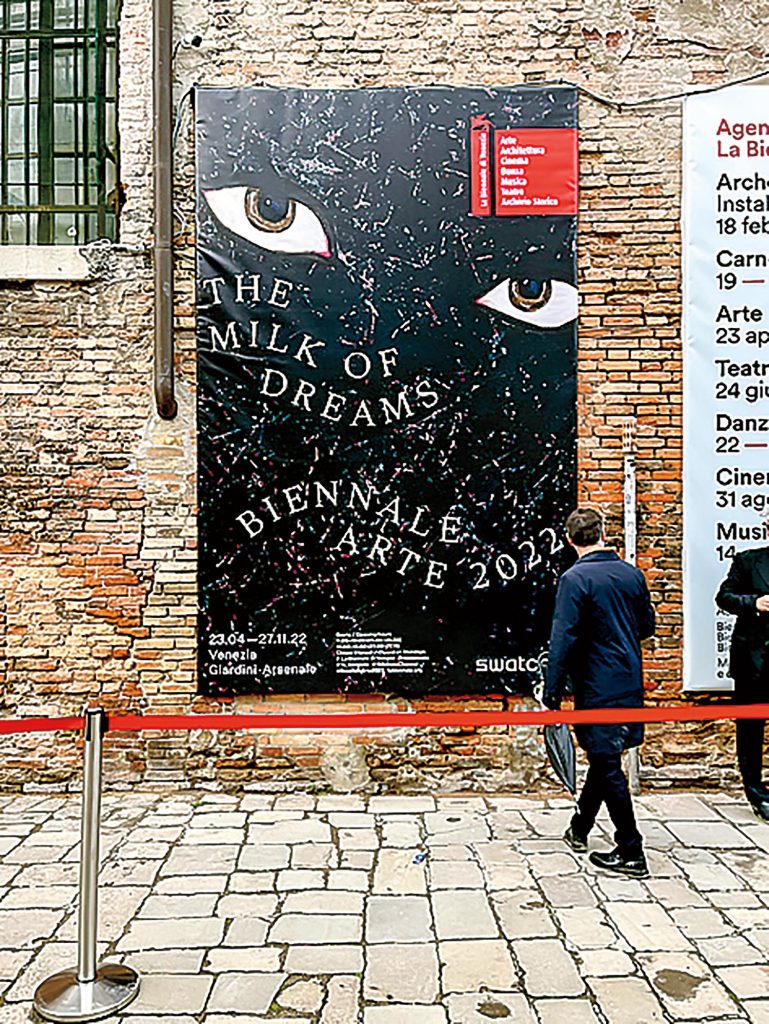
The Venice Biennale of 2023, with many locations throughout the city, was generally well received
This controversial experiment was short-lived, however, and the trustees tasked the next director John R. Lane to revive the show, returning it to its former glory within the pantheon of large shows of contemporary art. After a misstep in 1982, Lane did his own reassessment, canvassing international curators and directors. He reinstated the survey format with more works by fewer artists, a recommendation in the Mellon report. The ensuing shows were well received, and there was a giddiness at seeing such a variety of good art in Pittsburgh again, an optimism that carried forward into the ’90s and the new century.
The inclusion of voices from outside the Carnegie has continued. Since 1982, curators have assembled advisory teams. At their periodic meetings, these groups debated approaches. Should the International concentrate on clearly recognized and appreciated work with the so-called blue-chip artists already promoted by galleries or figure out how to include what critics referred to as the “shockers”? Should the show be grounded in a “retrospective or wrap-up” approach or be “predictive”? Should it be “controversial, promoting the intellectual dialogue about controversy” or remain “mainstream”? What was most relevant, the best art being produced or the new and interesting?
Critics chimed in, publishing mostly positive opinions, but some echoed John Canady who, in 1970, worried that the International was “an institution whose reasons for being are lost.” Hilton Kramer followed with a stinging review published in 1995 in the New York Observer. He believed that the “moribund enterprise” should be “put out of its misery,” because it was in “irreversible decline” and in an “intellectual coma,” its “mind gone, vision dimmed, and dignity shattered.” Strident words from a conservative and disdainful view of contemporary art were easy for the museum to dismiss. The time wasn’t right yet. But more and more questions were being asked with each new show. And attendance decreased from a high in 1985 to a low in 1995 of around 100,000 visitors.
***
Is it the right time for another such rethinking of the International?
Reviews of the 2022-23 International have been almost uniformly polite, with critics concentrating on what they felt worked in the show. Some had less enthusiastic reactions. The New York Times lumped the International and Documenta together, exposing curatorial abdications and deficiencies and lamenting that viewers had become “obsolete.” Art Forum said the show “[held] viewers at arm’s length,” and “that it consistently guides viewers toward a way of looking that feels significant, historically informed, and often didactic: a righteous and cerebral yet emotionally limited framework.”
Many people who have been involved with the International, either as curators or longtime viewers, emphasized to me how important the show is to a city like Pittsburgh. If the audience is Pittsburgh, especially considering the difficulty of traveling to our city and other extraordinary internationals competing for attention, how should the show be organized to remain relevant to both the art world and the dedicated and intelligent audiences of Pittsburgh?
Ideas vary. The museum could redistribute the $5 million-budget over the three-year period between Internationals, with an appreciable yearly bump for a constellation of International programs. There could be one curator per year or one curator for a three-year stint. An annual show, smaller and more focused, could still be the pivot, but more flexibility and less pressure on the big show would allow creative experimentation and, new formats, presentation models, and more community engagement. Rather than trying to encapsulate a particular moment in time in one show, multiple, moving parts could explore various strands or trends, some of which might be presented online or through lectures, films, or performances. Public programs could expand into podcasts and more current technologies, becoming more integrated components of an ongoing exploration of contemporary art and issues. A constant presence of contemporary art would continue to build a more in-tune audience here while still speaking to the informed.
The ideas and material are out there. Hyperallergic, one of the best online art sites, published a list of the top 50 exhibitions of 2022. Among the many topics featured in these shows were Native American, Asian American and Latinx art, post-hurricane Puerto Rico, Afrofuturism, the slave trade to Brazil and the U.S., and an update on an iconic feminist show from 1971. These choices reflect subjects rarely seen in Pittsburgh, any of which would present a more complex picture of what contemporary artists explore while considering the role artists play or want to play in relation to current ideas.
Whether you believe that the International succeeds with its current format or want to see reinvigorating changes, the revered tradition needs new ideas, new ways of operating. The tradition should be a living one, not a calcified one. Pittsburgh is not alone facing a new world order. There are visionaries who can invent new models for the 21st century. How will new generations of curators adapt the tradition? It would be refreshing to see a major rethink coming from within for that would benefit our city as a whole and the exhibition in each iteration. The Carnegie International can be part of the problem or part of the solution.



